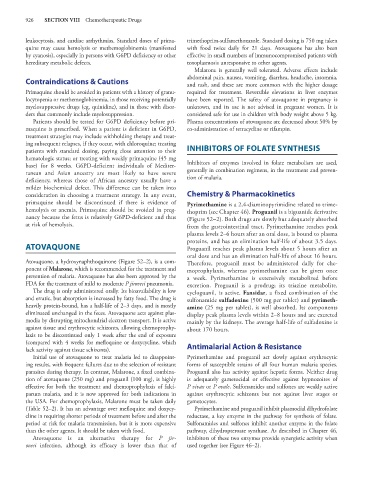Page 940 - Basic _ Clinical Pharmacology ( PDFDrive )
P. 940
926 SECTION VIII Chemotherapeutic Drugs
leukocytosis, and cardiac arrhythmias. Standard doses of prima- trimethoprim-sulfamethoxazole. Standard dosing is 750 mg taken
quine may cause hemolysis or methemoglobinemia (manifested with food twice daily for 21 days. Atovaquone has also been
by cyanosis), especially in persons with G6PD deficiency or other effective in small numbers of immunocompromised patients with
hereditary metabolic defects. toxoplasmosis unresponsive to other agents.
Malarone is generally well tolerated. Adverse effects include
Contraindications & Cautions abdominal pain, nausea, vomiting, diarrhea, headache, insomnia,
and rash, and these are more common with the higher dosage
Primaquine should be avoided in patients with a history of granu- required for treatment. Reversible elevations in liver enzymes
locytopenia or methemoglobinemia, in those receiving potentially have been reported. The safety of atovaquone in pregnancy is
myelosuppressive drugs (eg, quinidine), and in those with disor- unknown, and its use is not advised in pregnant women. It is
ders that commonly include myelosuppression. considered safe for use in children with body weight above 5 kg.
Patients should be tested for G6PD deficiency before pri- Plasma concentrations of atovaquone are decreased about 50% by
maquine is prescribed. When a patient is deficient in G6PD, co-administration of tetracycline or rifampin.
treatment strategies may include withholding therapy and treat-
ing subsequent relapses, if they occur, with chloroquine; treating
patients with standard dosing, paying close attention to their INHIBITORS OF FOLATE SYNTHESIS
hematologic status; or treating with weekly primaquine (45 mg
base) for 8 weeks. G6PD-deficient individuals of Mediter- Inhibitors of enzymes involved in folate metabolism are used,
ranean and Asian ancestry are most likely to have severe generally in combination regimens, in the treatment and preven-
deficiency, whereas those of African ancestry usually have a tion of malaria.
milder biochemical defect. This difference can be taken into
consideration in choosing a treatment strategy. In any event, Chemistry & Pharmacokinetics
primaquine should be discontinued if there is evidence of Pyrimethamine is a 2,4-diaminopyrimidine related to trime-
hemolysis or anemia. Primaquine should be avoided in preg- thoprim (see Chapter 46). Proguanil is a biguanide derivative
nancy because the fetus is relatively G6PD-deficient and thus (Figure 52–2). Both drugs are slowly but adequately absorbed
at risk of hemolysis. from the gastrointestinal tract. Pyrimethamine reaches peak
plasma levels 2–6 hours after an oral dose, is bound to plasma
proteins, and has an elimination half-life of about 3.5 days.
ATOVAQUONE Proguanil reaches peak plasma levels about 5 hours after an
oral dose and has an elimination half-life of about 16 hours.
Atovaquone, a hydroxynaphthoquinone (Figure 52–2), is a com- Therefore, proguanil must be administered daily for che-
ponent of Malarone, which is recommended for the treatment and moprophylaxis, whereas pyrimethamine can be given once
prevention of malaria. Atovaquone has also been approved by the a week. Pyrimethamine is extensively metabolized before
FDA for the treatment of mild to moderate P jiroveci pneumonia. excretion. Proguanil is a prodrug; its triazine metabolite,
The drug is only administered orally. Its bioavailability is low cycloguanil, is active. Fansidar, a fixed combination of the
and erratic, but absorption is increased by fatty food. The drug is sulfonamide sulfadoxine (500 mg per tablet) and pyrimeth-
heavily protein-bound, has a half-life of 2–3 days, and is mostly amine (25 mg per tablet), is well absorbed. Its components
eliminated unchanged in the feces. Atovaquone acts against plas- display peak plasma levels within 2–8 hours and are excreted
modia by disrupting mitochondrial electron transport. It is active mainly by the kidneys. The average half-life of sulfadoxine is
against tissue and erythrocytic schizonts, allowing chemoprophy- about 170 hours.
laxis to be discontinued only 1 week after the end of exposure
(compared with 4 weeks for mefloquine or doxycycline, which Antimalarial Action & Resistance
lack activity against tissue schizonts).
Initial use of atovaquone to treat malaria led to disappoint- Pyrimethamine and proguanil act slowly against erythrocytic
ing results, with frequent failures due to the selection of resistant forms of susceptible strains of all four human malaria species.
parasites during therapy. In contrast, Malarone, a fixed combina- Proguanil also has activity against hepatic forms. Neither drug
tion of atovaquone (250 mg) and proguanil (100 mg), is highly is adequately gametocidal or effective against hypnozoites of
effective for both the treatment and chemoprophylaxis of falci- P vivax or P ovale. Sulfonamides and sulfones are weakly active
parum malaria, and it is now approved for both indications in against erythrocytic schizonts but not against liver stages or
the USA. For chemoprophylaxis, Malarone must be taken daily gametocytes.
(Table 52–2). It has an advantage over mefloquine and doxycy- Pyrimethamine and proguanil inhibit plasmodial dihydrofolate
cline in requiring shorter periods of treatment before and after the reductase, a key enzyme in the pathway for synthesis of folate.
period at risk for malaria transmission, but it is more expensive Sulfonamides and sulfones inhibit another enzyme in the folate
than the other agents. It should be taken with food. pathway, dihydropteroate synthase. As described in Chapter 46,
Atovaquone is an alternative therapy for P jir- inhibitors of these two enzymes provide synergistic activity when
oveci infection, although its efficacy is lower than that of used together (see Figure 46–2).

